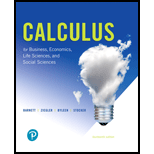
Useful life. A computer store rents time on desktop publishing systems. The total accumulated costs C(t) and revenues R(t) (in thousands of dollars) from a particular system satisfy
where t is the time in years that the system has been available for rental. Find the useful life of the system, and approximate the total profit during the useful life to within ±0.005.
Want to see the full answer?
Check out a sample textbook solution
Chapter 10 Solutions
Pearson eText for Calculus for Business, Economics, Life Sciences, and Social Sciences -- Instant Access (Pearson+)
- Let's assume p and q are true statements. What are the values of the statements below. A: (p→ q) →~p B: (p v~q) → ~(p^q) A: True B: False A: True B: True ☐ A: A: False B: False ☐ A: False B: Truearrow_forwardThree statements A, B and C are given below. Which choice is correct? (A) ~(p^~q) (B) ~p^q (c) pv~q ☐ All statements are inequivalent. ☐ Only statements A and B are equivalent. ☐ Only statements C and B are equivalent. ☐ Only statements A and C are equivalent.arrow_forward6: 000 Which truth table is correct for the given compound statement? (pvq)^p]→q A: B: P P 9 [(pvq)^p]→ 9 T T F T T T T F T T F F F T T F T F F F T F F T C: P 9 [(pvq)^p]→9 D: P 9 [pvq)^p]→9 T T T T T T TF T T F F F T F F T T F F F F F T B A D Previous Page Next Page Page 3 of 11arrow_forward
- st One Which truth table is correct for the given compound statement? (p→q)^~p A: P q (p→q)^~p B: P q (p→q)^~p T T F T T F T F F T F T F T T F T T F F F F F T C: D: P q (p→ q)^~p P 9 (p→q)^~p T T F T T T T F F T F F F T T F T T F F T F F T A U Oarrow_forward2) Find the general solution to the following differential equation. d²x dt² - dx 6 +25x = 64e¯* dtarrow_forward1) Solve the following initial value problem. y' + xy = x y(0) = −1arrow_forward
- 4.8^2^x^+1=32^x^+2arrow_forwardCalculate gross pay for each employee. All are paid overtime wage rates that are 1.5 times their respective regular wage rates. should be rounded to two decimal places at each calculation.arrow_forwardTaylor Series Approximation Example- H.W More terms used implies better approximation f(x) 4 f(x) Zero order f(x + 1) = f(x;) First order f(x; + 1) = f(x;) + f'(x;)h 1.0 Second order 0.5 True f(x + 1) = f(x) + f'(x)h + ƒ"(x;) h2 2! f(x+1) 0 x; = 0 x+1 = 1 x h f(x)=0.1x4-0.15x³- 0.5x2 -0.25x + 1.2 51 Taylor Series Approximation H.w: Smaller step size implies smaller error Errors f(x) + f(x,) Zero order f(x,+ 1) = f(x) First order 1.0 0.5 Reduced step size Second order True f(x + 1) = f(x) + f'(x)h f(x; + 1) = f(x) + f'(x)h + "(xi) h2 f(x,+1) O x₁ = 0 x+1=1 Using Taylor Series Expansion estimate f(1.35) with x0 =0.75 with 5 iterations (or & s= 5%) for f(x)=0.1x 0.15x³-0.5x²- 0.25x + 1.2 52arrow_forward
- Calculate gross pay for each employee. All are paid overtime wage rates that are 1.5 times their respective regular wage rates. should be rounded to two decimal places at each calculation.arrow_forwardNo chatgpt pls will upvotearrow_forward1. 2. Show that the following are not logically equivalent by finding a counterexample: (p^q) →r and (db) V (d←d) Show that the following is not a contradiction by finding a counterexample: (pV-q) AqA (pv¬q Vr) 3. Here is a purported proof that (pq) ^ (q → p) = F: (db) v (bd) = (db) v (bd) =(qVp) A (g→p) = (¬¬q V ¬p) ^ (q→ p) (db) V (db) = =¬(a→p)^(a→p) = (gp) ^¬(a → p) =F (a) Show that (pq) ^ (q→p) and F are not logically equivalent by finding a counterex- ample. (b) Identify the error(s) in this proof and justify why they are errors. Justify the other steps with their corresponding laws of propositional logic.arrow_forward
- Algebra & Trigonometry with Analytic GeometryAlgebraISBN:9781133382119Author:SwokowskiPublisher:Cengage
 Algebra and Trigonometry (MindTap Course List)AlgebraISBN:9781305071742Author:James Stewart, Lothar Redlin, Saleem WatsonPublisher:Cengage Learning
Algebra and Trigonometry (MindTap Course List)AlgebraISBN:9781305071742Author:James Stewart, Lothar Redlin, Saleem WatsonPublisher:Cengage Learning Linear Algebra: A Modern IntroductionAlgebraISBN:9781285463247Author:David PoolePublisher:Cengage Learning
Linear Algebra: A Modern IntroductionAlgebraISBN:9781285463247Author:David PoolePublisher:Cengage Learning  College AlgebraAlgebraISBN:9781305115545Author:James Stewart, Lothar Redlin, Saleem WatsonPublisher:Cengage Learning
College AlgebraAlgebraISBN:9781305115545Author:James Stewart, Lothar Redlin, Saleem WatsonPublisher:Cengage Learning
 Glencoe Algebra 1, Student Edition, 9780079039897...AlgebraISBN:9780079039897Author:CarterPublisher:McGraw Hill
Glencoe Algebra 1, Student Edition, 9780079039897...AlgebraISBN:9780079039897Author:CarterPublisher:McGraw Hill





